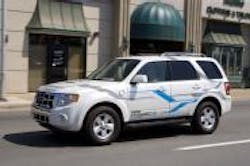“This is the kind of collaborative effort that is required to address the big global challenges of energy independence and environmental sustainability.” –Alan Mulally, president and CEO, Ford Motor Co.
It’s been no secret that OEMs across the vehicle spectrum believe hybrid technology – systems combining battery-driven electric motors with their diesel or gasoline counterparts – offers perhaps the simplest way to reduce fuel consumption in the transportation sector.
Now, when we use the term “simple” here, let’s be clear about the context. This isn’t “simple” technology by any means. Rather, it’s just “simpler” in comparison to what’s needed in terms of both vehicle technology and infrastructure to switch to natural gas, propane, or even all-electric vehicles.
For in the case of hybrids, diesel or gasoline engine produce the electrical “juice” to recharge the vehicle’s battery pack – providing a “closed loop” propulsion system of sorts that doesn’t have to rely on a refueling infrastructure outside of the one already in existence to support petroleum-powered equipment.
That’s what seems to be driving a new development partnership just inked between Ford Motor Co. and Toyota Motor Co. aimed (in part) at crafting new hybrid systems for light trucks and sport utility vehicles (SUVs).
The companies said they should have a new “co-developed” hybrid system ready for use later this decade on Ford and Toyota rear-wheel-drive light trucks and SUVs based on a “memorandum of understanding” or "MOU" this product development collaboration they’ve signed, with a formal agreement along the same lines expected by next year.
Both believe that their collaboration will allow them to bring such hybrid technologies to customers sooner and make them more affordable than either company could have accomplished alone, noted Derrick Kuzak, Ford’s group vice president for global product development said in joint press conference with his counterpart at Toyota, Takeshi Uchiyamada, executive vice president for research & development.
“Our collaboration with Ford is a move to make hybrid technology more widely available in sport-utility vehicles and in trucks,” Uchiyamada added. “Those kinds of models are indispensable to American customers. And providing them with our hybrid technology will help conserve energy and reduce output of greenhouse gas here in the U.S. That was our thinking in considering the collaboration.”
He also noted that this new rear-wheel-drive hybrid system the two are developing will be based on an all-new architecture to deliver the capability truck and SUV customers demand while providing greater fuel economy.
While this jointly-developed rear-wheel-drive hybrid system will share significant common technology and components, Ford and Toyota stressed that they’ll individually integrate the system into their own vehicles. Each company also will determine the calibration and performance dynamics characteristics of their respective light pickups and SUVs, they said.
The two are also going to jointly work on telematics systems as well, collaborating on standards and technologies needed to enable a safer, more secure and more convenient in-car experience. However, they stressed that this telematics collaboration relates only to standards and technologies, and each company will continue to separately develop their own in-vehicle products and features.
I’ll tell you one thing – I look forward to test driving trucks equipped with both the new hybrid and telematics systems Ford and Toyota are now working on.
